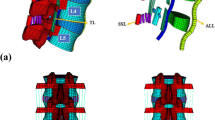Abstract
The risk of accelerating the degeneration of adjacent disc levels after lumbar spinal fusion is a controversial issue. A finite element model consisting of L1 to L5 lumbar spines was used to assess the effect on adjacent disc level after lumbar spinal fusion. We compared intact, L4/5 posterior interbody fusion (PLF), and L4/5 posterior lumbar interbody fusion (PLIF) models. The loading conditions applied were compressive force, compressive force plus flexion moment, and compressive force plus extension moment. Evaluations were made for von Mises stress on each vertebral end-plate, Tresca stress of all the annulus fibrosus, and Tresca stress of the annulus fibrosus from the posterior surface of the disc to the neural foramen. As the result, the von Mises stress adjacent to the fusion level was higher than the other nonfusion levels; it was higher under conditions of flexion moment loading plus compression loading [112% (2.59 PMa) in the PLF model and 117% (2.72 Mpa) in the PLIF model] than in the intact model. The Tresca stress of all the annulus fibrosus adjacent to the fusion level was higher than that on other nonfusion intervertebral levels; it was higher under conditions of flexion moment loading plus compression loading [127% (0.57 PMa) in the PLF model and 209% (0.89 Mpa) in the PLIF model] than in the intact model. The Tresca stress of the annulus fibrosus from the posterior surface of the disc to the neural foramen adjacent to the fusion level was higher than that on other nonfusion intervertebral levels; and it was higher under conditions of flexion moment loading plus compression loading [107% (1.48 PMa) in the PLF model and 112% (1.54 Mpa) in the PLIF model] than in the intact model. These findings demonstrate that with lumbar fusion, stresses on the vertebral end-plate and the annulus fibrosus were high adjacent to the fusion level; furthermore, stresses were higher in the PLIF model than in the PLF model. These results suggested that lumbar spinal fusion might bring with it a risk of damage to the annulus fibrosus and the vertebral end-plate adjacent to the fusion level.
Similar content being viewed by others
Author information
Authors and Affiliations
About this article
Cite this article
Goto, K., Tajima, N., Chosa, E. et al. Effects of lumbar spinal fusion on the other lumbar intervertebral levels (three-dimensional finite element analysis). J Orthop Sci 8, 577–584 (2003). https://doi.org/10.1007/s00776-003-0675-1
Received:
Accepted:
Issue Date:
DOI: https://doi.org/10.1007/s00776-003-0675-1




